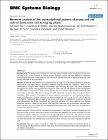| dc.contributor.author | HINTON, JAY | |
| dc.date.accessioned | 2010-04-28T16:43:57Z | |
| dc.date.available | 2010-04-28T16:43:57Z | |
| dc.date.issued | 2009 | |
| dc.date.submitted | 2009 | en |
| dc.identifier.citation | Pin C, Rolfe MD, Mu?oz-Cuevas M, Hinton JC, Peck MW, Walton NJ, Baranyi J, Network analysis of the transcriptional pattern of young and old cells of Escherichia coli during lag phase., BMC Systems Biology, 3, 108, 2009 | en |
| dc.identifier.other | Y | |
| dc.identifier.uri | http://hdl.handle.net/2262/39267 | |
| dc.description | PUBLISHED | en |
| dc.description.abstract | Background
The aging process of bacteria in stationary phase is halted if cells are subcultured and enter lag phase and it is then followed by cellular division. Network science has been applied to analyse the transcriptional response, during lag phase, of bacterial cells starved previously in stationary phase for 1 day (young cells) and 16 days (old cells).
Results
A genome scale network was constructed for E. coli K-12 by connecting genes with operons, transcription and sigma factors, metabolic pathways and cell functional categories. Most of the transcriptional changes were detected immediately upon entering lag phase and were maintained throughout this period. The lag period was longer for older cells and the analysis of the transcriptome revealed different intracellular activity in young and old cells. The number of genes differentially expressed was smaller in old cells (186) than in young cells (467). Relatively, few genes (62) were up- or down-regulated in both cultures. Transcription of genes related to osmotolerance, acid resistance, oxidative stress and adaptation to other stresses was down-regulated in both young and old cells. Regarding carbohydrate metabolism, genes related to the citrate cycle were up-regulated in young cells while old cells up-regulated the Entner Doudoroff and gluconate pathways and down-regulated the pentose phosphate pathway. In both old and young cells, anaerobic respiration and fermentation pathways were down-regulated, but only young cells up-regulated aerobic respiration while there was no evidence of aerobic respiration in old cells.
Numerous genes related to DNA maintenance and replication, translation, ribosomal biosynthesis and RNA processing as well as biosynthesis of the cell envelope and flagellum and several components of the chemotaxis signal transduction complex were up-regulated only in young cells. The genes for several transport proteins for iron compounds were up-regulated in both young and old cells. Numerous genes encoding transporters for carbohydrates and organic alcohols and acids were down-regulated in old cells only.
Conclusion
Network analysis revealed very different transcriptional activities during the lag period in old and young cells. Rejuvenation seems to take place during exponential growth by replicative dilution of old cellular components. | en |
| dc.language.iso | en | en |
| dc.publisher | BioMed Central | en |
| dc.relation.ispartofseries | BMC Systems Biology; | |
| dc.relation.ispartofseries | 3; | |
| dc.relation.ispartofseries | 108; | |
| dc.rights | Y | en |
| dc.subject | Microbiology | |
| dc.title | Network analysis of the transcriptional pattern of young and old cells of Escherichia coli during lag phase. | en |
| dc.type | Journal Article | en |
| dc.contributor.sponsor | Biotechnology and Biological Sciences Research Council | en |
| dc.type.supercollection | scholarly_publications | en |
| dc.type.supercollection | refereed_publications | en |
| dc.identifier.peoplefinderurl | http://people.tcd.ie/hintonj | |
| dc.identifier.rssinternalid | 65234 | |
| dc.identifier.rssuri | http://www.biomedcentral.com/1752-0509/3/108 | en |




